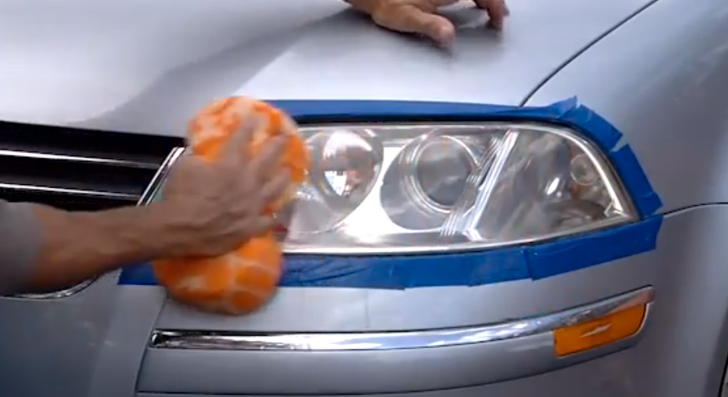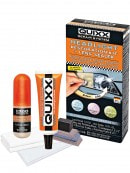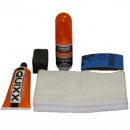So you’ve got an older model car that’s been on the road for way too long. You’ve put a lot of hours into it and the fuel economy is still good enough even though the years have not been kind to the body. Oh sure, you can clean the interior, wash it and have it smelling like new but you can never fix those smaller details on the car, like those corroded headlights. Or can you?
The plastic at he front of the headlights gets damaged by salt, dust, stone chips and pollutants in the air. After a few years, it loses all its shine, small cracks appear and the plastic gets a yellowish color to it. Visibility is severely reduced and as a consequence driving at night becomes more dangerous. Unfortunately, buying a new set of headlights is very expensive which is why most people are put off by the repair, but as always there is an alternative solution.
There are a number of headlight restoration kits out there, most of them costing under $50, which considering what you pay for a new set even from a breakers yard is quite reasonable.
We’ve looked at a number of products and found one we particularly like, the Quixx Repair System “Headlight Restoration Kit + Lens Sealer”, retailing for around $19.99 (but you can find it for a lot less). We prefer this one because it’s a real DIY kit, with no power tools required.
The first step would be to clean the headlights to remove impurities. Use a microfiber cloth to do this because anything you leave on there will put new scratches during the sanding and buffing process. After you’re done, wipe with a dry microfiber cloth and let it dry in the sun. Next up, you need to mask off the areas around the headlight to stop you from scratching it. Use plastic tape, not paper, because you’re going to get it wet. Another quick tip is to open the hood so you don’t have to mask that off and put a layer of food wrap underneath the tape to stop the car from getting dirty.
From then on, the process is pretty much wet sanding with 5000, 3000 and 2000 grit paper, done by hand using a little rubber block. It’s important to constantly have water on there for better results because the heat created by friction would otherwise warp the headlight plastic. The best way to tackle the wet sanding is to use one type of sanding paper in one direction and the other in another, say use the 3000 vertically and the other one horizontally. Do not make circular movements and don’t try to rush the process with a sander. The last step to getting a good finish is to use the scratch remover product and buff the headlight with it. After that Quixx provides a sealer spray which you have to rub into using a cloth. This stops the dust and corrosive substances on the road from getting into the plastic that quickly. You put it on and leave it there for a good 15 minutes.
After that, just enjoy getting complements from your friends for a job well done, or maybe tell them you bought brand new headlights as a joke.
If you really want to go low-tech, some people suggest using toothpaste. The idea is that any light abrasive works, just like you can use baking soda or salt to scrub your bathtub. The only problem with that idea is that if you use the wrong substance on your headlights, you risk creating tiny imperfects which will catch dust and corrosive substances even faster. This is why we don’t recommend using abrasive substances that were designed to do something else.
And a silly commercial, why not?
There are a number of headlight restoration kits out there, most of them costing under $50, which considering what you pay for a new set even from a breakers yard is quite reasonable.
We’ve looked at a number of products and found one we particularly like, the Quixx Repair System “Headlight Restoration Kit + Lens Sealer”, retailing for around $19.99 (but you can find it for a lot less). We prefer this one because it’s a real DIY kit, with no power tools required.
The first step would be to clean the headlights to remove impurities. Use a microfiber cloth to do this because anything you leave on there will put new scratches during the sanding and buffing process. After you’re done, wipe with a dry microfiber cloth and let it dry in the sun. Next up, you need to mask off the areas around the headlight to stop you from scratching it. Use plastic tape, not paper, because you’re going to get it wet. Another quick tip is to open the hood so you don’t have to mask that off and put a layer of food wrap underneath the tape to stop the car from getting dirty.
From then on, the process is pretty much wet sanding with 5000, 3000 and 2000 grit paper, done by hand using a little rubber block. It’s important to constantly have water on there for better results because the heat created by friction would otherwise warp the headlight plastic. The best way to tackle the wet sanding is to use one type of sanding paper in one direction and the other in another, say use the 3000 vertically and the other one horizontally. Do not make circular movements and don’t try to rush the process with a sander. The last step to getting a good finish is to use the scratch remover product and buff the headlight with it. After that Quixx provides a sealer spray which you have to rub into using a cloth. This stops the dust and corrosive substances on the road from getting into the plastic that quickly. You put it on and leave it there for a good 15 minutes.
After that, just enjoy getting complements from your friends for a job well done, or maybe tell them you bought brand new headlights as a joke.
If you really want to go low-tech, some people suggest using toothpaste. The idea is that any light abrasive works, just like you can use baking soda or salt to scrub your bathtub. The only problem with that idea is that if you use the wrong substance on your headlights, you risk creating tiny imperfects which will catch dust and corrosive substances even faster. This is why we don’t recommend using abrasive substances that were designed to do something else.
And a silly commercial, why not?








